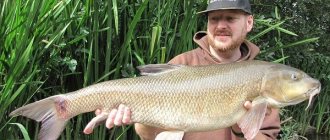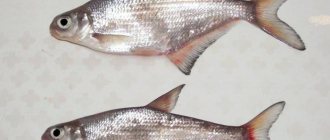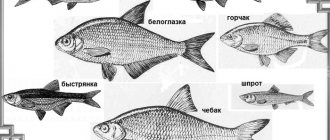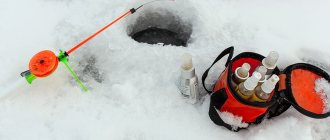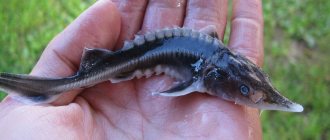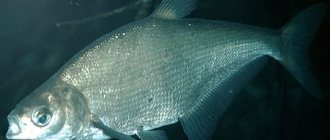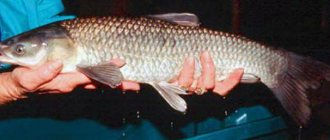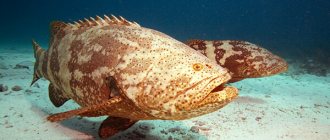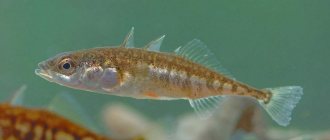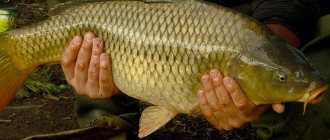Palia is a salmon fish from the genus Loach. It differs from other representatives of the genus in its bright color and large head. There are small teeth in the mouth. It is a commercial fish, but due to a sharp decline in the population, there are restrictions on its catching.
Under natural conditions, it lives only in cold water bodies.
Palia – it’s a pity that there is so little of her
Despite its almost unlimited habitat, catching a palia is a great success. In many places it was even listed in the Red Book, however, despite measures for its protection and artificial breeding, the population in natural reservoirs is declining. Of course, there are places where this amazing fish can not only be caught (theoretically), but also caught.
For example, in lakes Ladoga and Onega, palia is a commercial fish, but a sharp decrease in the number of fish has led to forced bans and restrictions on its catching. It is worth noting that in terms of the quality of its aromatic and tender meat, palia is ahead of many other salmon, however, the number of those who can boast of the ability to cook this fish decreases in proportion to the decrease in the number of caught individuals.
Geography of Palia habitat
Palia is considered a fish of deep lakes, lives in Lake Ladoga, Lake Onega, Palyozero, Topozero, Segozero, Umboozero and other lakes of North Karelia and the Kola Peninsula. Lake charr are also found in cold water bodies of Finland and Sweden. Sometimes they are found swimming in the sea, but they go to spawn in rivers that flow into the waters of cold oceans.

The fish has a large head and a predatory mouth
A separate variety of palia is the American one, which lives in cold lakes of North America with a rocky bottom. This species does not tolerate water pollution well, and reproduces well only in reservoirs enriched with oxygen.
Biological description
Palia is a typical representative of the genus of loaches, although even among scientists there are often disputes about the exact classification of its individual subspecies and the biological characteristics of this fish, which even today is clearly insufficiently studied. Most often, two forms of palia are distinguished, one of which is called ordinary (red or puddle), the second - ridge (or pit). As the name suggests, the permanent habitat of the pit fish is the deepest parts of the reservoir, and there are known cases of discovering this fish at depths reaching 150 meters. For spawning, the fish goes where it is smaller, and at this time it is easy to distinguish it from ordinary palya by its uniform silver body color, without orange spots. The average weight of a mature individual does not exceed 2 kg, although there are known cases of catching fish weighing 5 kilograms or even more.
Red palia is found in large quantities and lives at shallow depths, often choosing for hunting places in reservoirs where the water layer does not even reach a meter. The fish is very beautiful and has a dark color with a greenish and sometimes bluish tint on the back. The sides are silvery, and the ventral part is painted bright orange, and numerous small white spots resembling pearls are scattered throughout the body. The color of the common falcon becomes especially bright during spawning, which is why the fish received the name red. Ludozhnaya paliya is larger than kryazhevy, and individual specimens reach a weight of almost 10 kg.
Fish "Palia" photo and description
Latin name:
Salvelinus lepechini
Other names:
paglia
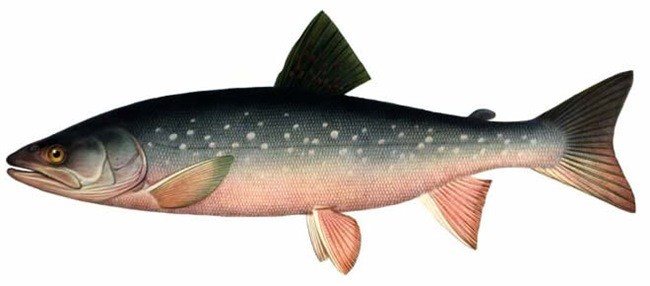
Family:
Salmonidae
Genus:
Loaches
Type:
freshwater
Lifestyle:
pelagic
Diet type:
carnivorous
Habitat:
Baltic Sea basin, Arctic Ocean basin
Description:
In some classifications it appears as a sedentary form of arctic char, but according to others it is distinguished as a separate species, Salvelinus lepechini. Previously, due to its extreme similarity, palia was classified as a noble salmon (Salmo).
Appearance:
Palia are very diverse in color. They are darker than anadromous loaches, the belly is pink, the anterior rays of the paired fins and anal fins and the lower ray of the caudal fin are white. The sides are usually covered with yellowish and orange spots. Some forms are almost black in color. In Lakes Ladoga and Onega, two forms of palia are distinguished: Ludozhnaya (red) and kryazhevoy (gray). Ludozhnaya palia is darker, stays at a shallower depth, spawns in autumn on luds and sands and reaches 5-7 kg in weight. The ridge, or pit, palia is lighter in color, lives at a depth of 70-150 m, can spawn in the spring, and usually weighs up to 2 kg.
Habitat and behavioral characteristics:
Palia is a fish of deep lakes and is found here only in some Finnish lakes, in Ladoga, and then exclusively in its northern part, in Onega and a few other lakes of the Olonets Bay, namely Palozero, Segozero and Elmozero. In Western Europe, it is found in the mountain lakes of Tyrol, Switzerland, Scotland and Sweden.
Nutrition Features:
In some deep-sea alpine lakes, palia also split into a number of forms, and there in one lake you can catch “ordinary” palia, small ones that feed on plankton, sometimes with a silvery color, and large, dark-colored ones that live at great depths and lead a predatory lifestyle.
PALIA – Salmo salvelmus L. On Lake Ladoga – Nerius, Nerias, Palia; in St. Petersburg - palga. On Onega they are distinguished by the meadow palya, or soft, red, red-finned palya and the bucktail palya, the mallard; on Lake Ladoga, the ridge palya is called Yamnaya. Barren male palya on Lake Onega. - messenger. Finnish – nierie, young – peguli.

This fish, recently, about 20 years ago, was studied by Prof. Kessler, has a very limited distribution in Russia. Palia is a fish of deep lakes and is found here only in some Finnish lakes, in Ladoga, and then exclusively in its northern part, in Onega and a few other lakes of Olonets province, namely Palozero, Segozero and Elmozero. In Western Europe, it is found in the mountain lakes of Tyrol, Switzerland, Scotland and Sweden. It is still unknown, however, whether there is one type of pallia or several. Most of the Onega fishermen distinguish two breeds of this fish, namely the ludozhnaya palya, or ludnaya, and the ridge palya. The first, according to them, is lighter, with reddish or whitish fins, is distinguished by a large head, has soft, crumbly meat, stays in shallower depths, spawns in the fall, near Pokrov, in puddles and sands, especially in puddles consisting of small pebbles, and reaches a weight of up to 14 and even 18 pounds, the second, according to their testimony, is darker, has gray fins, almost the same color as the “bark” of the body, a relatively small head, is distinguished by denser and red meat, lives at great depths, spawns in the spring , and sometimes does not spawn at all, and weighs most from 2 to 5 pounds, very rarely up to 10 or 12 pounds. Ludozhnaya palya is sometimes also called soft, red or redfin palya. It is called red not from the color of the meat (which, on the contrary, is whitish), but from the color of the belly. The mullet, otherwise known as the mullet, is so named because it stays at depth near rock ridges and also spawns near rock pools.
These two breeds of palya, distinguished by Onega fishermen, obviously correspond to two breeds also accepted in the north of Lake Ladoga, only the Ludozhnaya and smaller one is called Nerius by the Ladoga residents, and the Onega ridge palya is called Yamnaya. The first one usually stays here at a depth of 2 to 5 fathoms, has a reddish belly and fins and weighs up to 11 pounds, and the so-called. Yamnaya lives at a depth of 25 to 80, even 150 fathoms (depending on the time of year), has gray or whitish fins and rarely weighs up to 8 pounds. Of course, it is very possible that one breed of palya originated from another, but the differences presented, if we take into account the fact that the ridge palya, according to the testimony of Onega fishermen, spawns in the spring and not in the fall, is enough to consider them a special species. This question, in any case, requires further research, since, apparently, even Prof. Kessler. In general, the pallia is subject to very large changes, not only in the color of the body and fins, but even in the shape of the head. The sides of the body are bluish-gray, which on the belly gradually turns into whitish, yellowish or reddish, sometimes even bright pink-red. The head is always darker than the body. Unpaired fins are almost always greenish or brownish-gray, blackish towards the apex; the dorsal fin, moreover, often has vague dark spots, the anal fin has a more or less red tint, and the anterior edge of the anus is almost always white or whitish. The paired fins always more or less match the color of the belly. Apparently, the most beautiful and red-bellied pagli are not found during spawning; on the contrary, according to the testimony of Onega fishermen, they are always single, indivisible. This kind of barnacle paglia is called by some simple, or red, it is found more often and never has caviar. Messengers are probably the name given here to barren males; These messengers are distinguished by their thin body, as a result of which they appear long and thick-headed. Male palya - “men”, as Onega fishermen call them - moreover, have a relatively large head and are usually relatively larger than the “queens”. However, it should be noted that in general the relative size of the head of the palli does not decrease with age, as in other fish, but rather increases.
Judging by the large number of spawning indivisibles, it is necessary to come to the conclusion that not all palyas spawn every year, and sometimes two years or more pass from one palya spawning to another. In addition, it must be assumed that the eggs of this fish do not all reach maturity immediately, so their spawning must continue for a very considerable time. This can be concluded from the fact that in the palia caught in October, Prof. Kessler noticed mature, large caviar and at the same time very small. Palya spawns near Pokrov, on rocky ledges and coarse sandy shallows. Its caviar is relatively small (from 10 to 30 thousand, according to Beneke), but it is large, exactly the size of a pea (4-5 million). Its development should proceed very quickly compared to the eggs of other fish spawning in autumn and, apparently, ends in the same year, since young fish, less than a finger in length, according to fishermen, are caught in winter in abundance under the ice. In general, palya loves cold and stagnant water, and therefore lives exclusively at great lake depths, where the water temperature remains the same at almost every time of the year. This is a purely lake fish, which is only extremely rarely and accidentally spotted in rivers (for example, in the Suna, and then only once), and Lepekhin’s testimony that it is found in the mountain streams of Olonets Gubernia is probably caused by some kind of mistake. The main fishing for palya is not in Ladoga, but in Lake Onega, where it is widespread and where even two islands (Palyostrov and Palyak) got their name from it. They catch it from August 15 to early October, mainly during spawning - with seines, at other times (summer) - with deep bottom maselgi (i.e., nets) baited with smelt.
The main food of palya, even small ones, is various fish, especially vendace and smelt, also water beetles and crustaceans, most often various types of amphipods (Gammarus - mormysh on the Ural lakes), very numerous in Lakes Ladoga and Onega. Both large and small palya stay at depths all summer, very rarely going out onto small rocky places, and then, apparently, only because at this time of year it is extremely disturbed by external parasites, which are found on palya extremely often and in large numbers. quantity. There is almost no palya that does not have several pieces of parasitic crustaceans from the river. lerneopods (Lerneopoda salmonea) on various parts of its body, on the fins, on the inside of the gill covers and on the gills themselves, even on the scales. These crustaceans most readily attach themselves to the lower fins, especially the pectoral ones, where up to a dozen or more of them can often be found. In addition, fish leeches (Acanthobdella pelidina) attach themselves to the belly and fins (including the anus). These parasites are very well known to fishermen, according to whose testimony they sometimes completely corrode the fins of the pali. Fishermen say that the palya, tormented by its parasites, deliberately rises from the depths, approaches the ridges and tries in every possible way, through warm water and friction, to get rid of them. In addition, the pali's numerous gastric appendages are chock-full of tapeworms (especially Bothriocephalus proboscideus, which is also found in other related fish - salmon and taimen). If we accept that the palya has an average of about 45 gastric appendages and that each appendage contains at least 12 worms, then it turns out that each fish contains about 540 ribbon fish, some of which are up to one foot or more in length. Without any doubt, the softness and fragility of the palli meat should be attributed to this circumstance; This is confirmed by my observations of the wormish fish of the Trans-Ural lakes and by the fact that palya, living at great depths, has stronger, denser and redder meat. I even believe, by analogy with the fish of the Trans-Ural lakes, that the large number of barnacles is determined precisely by the parasites that deplete the fish; Probably, the red color of the belly and fins depends on the friction of the fish on the stones.
In general, palli meat is always softer and more crumbly than salmon and especially whitefish meat, and as a result is less durable and suitable for preservation. For the same reason, paglia, according to experts, is good for pie, but not suitable for fish soup. This fish is brought to St. Petersburg only in autumn and winter, live in cages or frozen, and, apparently, nowhere is it prepared for future use by salting and smoking. As for fishing palya, it seems that it is not caught anywhere with a fishing rod, except for hand fishing on Vygozero and Segozero, where, according to Gomilevsky, it is fished on a hook 5 inches long, embedded in an oval-shaped tin spatula and weighing 1 lb. A line, 20 fathoms long, is tied to a hole made in the spatula and lowered to a depth, and vendace or smelt is attached to the hook; the fishing line is held in hands, without a fishing rod. In the lakes of Western Europe, palya (or a species very close to it) is also caught on a fishing rod very rarely, for the same reason, i.e., almost constant presence at enormous depths. Only in wind and rain, when the palya comes to the surface, is it caught sometimes on large salmon flies; It is most convenient to catch it on a track or on a live, also dead, fish, which is lowered into the water or deeper, behind the boat, or they are caught on a fish, like a spoon, lowering and lifting it.
Since palya, in contrast to trout, lives in large schools and generally leads a more social lifestyle than other species close to it, this fishing can be quite productive. In the Bavarian mountain lakes, according to Bischof, palya (actually Salmo umbla) is caught mainly on floating lines with a barrel instead of a float, to which a strong twine up to 100 fathoms in length is attached; at a distance of every 3-4 fathoms of this line, short (1 foot) leashes with double hooks are tied when the inlet is lowered into the water; The leash is first threaded, using a needle, through the fish’s mouth into the anus, so that the hook sticks out of the mouth. The upper nozzle should be 6 fathoms from the surface. This entire projectile is released to the will of the wind, and the string takes an indirect position. In another method, the bait here is a live fish, released on a very long string tied to a board, barrel or bubble; the fish is placed on a double hook without a barb, which is threaded with a leash behind the gills, from the side, using a needle, under the skin, so that the leash comes out at the anal fin, also on the side of the body. Despite the fact that palya lives almost exclusively in deep lakes, recently it has been kept in many key ponds in Austria and Bavaria, and here it gets along very easily, very quickly fattens up with the meat of fish and mammals, cut into pieces, but almost never reproduces , why it has to be bred artificially, taking breeding specimens or fertilized eggs from large lakes. Palia is a sociable and quiet fish, not nearly as predatory as salmon and trout, and therefore can live anywhere with fish of other breeds and different ages. Paglia bastards with trout and salmon taste excellent and grow extremely quickly, like all sterile animals.
Author: L.P.Sabaneev
FISH CATALOG
